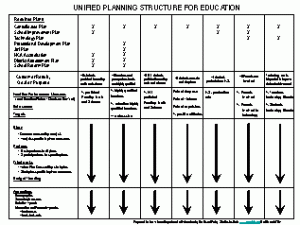Schools and school districts are beset with numerous planning requirements set out by federal, state, and in some cases private agencies. Much of this planning is duplicative. All of it is time consuming. What follows is an approach to unified planning for education which would allow planning to be done once using a sensible and common sense approach. Various planning requirements are then met by assembling the part of the of the unified plan which are called for in a particular required plan. This approach was developed for the Arizona Department of Education, but does not reflect official policy of that department.
Slide Animation Narrative
This slide shows an approach to unified planning for schools and school districts
First it shows the 8 separate plans required. The unified planning process works like this:
CLICK 1: First we identify the most important customer results, goals or purposes we hope to achieve.
CLICK 2
These include, for example, All students are proficient in reading, math and science, all teachers and para professionals are highly qualified etc.
CLICK 3
Then we identify headline performance measures for each customer result, purpose or goal.
CLICK 4
For example, the % proficient in reading, math and science, the % of highly qualified teachers and the retention rate for such teachers, etc.
Then we go through the Results-Based Accountability thinking process for each customer result, goal or purpose:
CLICK 5
The Story behind the baselines for each measure, the partners who have a role to play in doing better; what works to do better and our action plan; and how our action plan is to be funded.
CLICK 6
Then we do the same thing for a set of appendices
CLICK 7
CLICK 8
These appendices contain backup information about demographics, secondary performance measures (that didn�t make the cut as a headline measure but are still important), our data development agenda so we can continue to improve our data, and our information and research agenda.
We now have seven components of an improvement plan, aligned by customer result, goal or purpose, that are not duplicative.
Then we can identify which of the seven components go into each of the 8 required plans.
CLICK 9
When it comes time to produce one of the plans you just copy the appropriate components.

